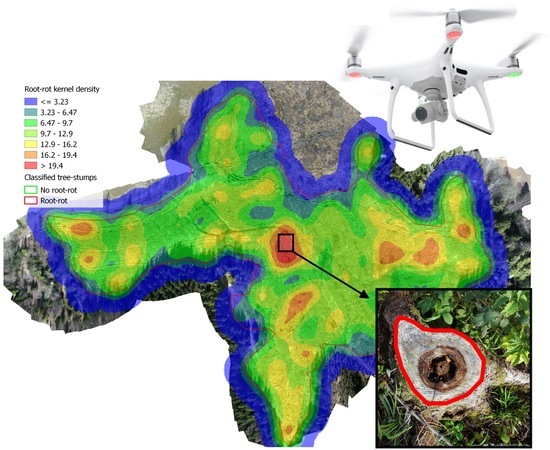Tree-Stump Detection, Segmentation, Classification, and Measurement Using Unmanned Aerial Vehicle (UAV) Imagery
Abstract
:1. Introduction
1.1. Background
1.2. Aim
2. Materials
2.1. Study Area
2.2. Field Data
2.3. Remotely Sensed Data
3. Method
3.1. Detection and Segmentation
3.2. Machine Learning Random Forest Classification
3.3. Diameter Measurement and Modelling
4. Results
4.1. Tree-Stump Detection
4.2. Root- and Butt-Rot Machine Learning Classification
4.3. Diameter Direct Measurement and Modelling
5. Discussion
6. Conclusions
Acknowledgments
Author Contributions
Conflicts of Interest
References
- Tang, L.; Shao, G. Drone remote sensing for forestry research and practices. J. For. Res. 2015, 26, 791–797. [Google Scholar] [CrossRef]
- Puliti, S.; Ørka, H.; Gobakken, T.; Næsset, E. Inventory of small forest areas using an unmanned aerial system. Remote Sens. 2015, 7, 9632. [Google Scholar] [CrossRef] [Green Version]
- Pierzchała, M.; Talbot, B.; Astrup, R. Estimating soil displacement from timber extraction trails in steep terrain: Application of an unmanned aircraft for 3d modelling. Forests 2014, 5, 1212. [Google Scholar] [CrossRef]
- Goodbody, T.R.H.; Coops, N.C.; Tompalski, P.; Crawford, P.; Day, K.J.K. Updating residual stem volume estimates using als- and uav-acquired stereo-photogrammetric point clouds. Int. J. Remote Sens. 2017, 38, 2938–2953. [Google Scholar] [CrossRef]
- Talbot, B.; Rahlf, J.; Astrup, R. An operational uav-based approach for stand-level assessment of soil disturbance after forest harvesting. Scand. J. For. Res. 2017, 1–10. [Google Scholar] [CrossRef]
- Jaskierniak, D.; Kuczera, G.; Benyon, R.G.; Lucieer, A. Estimating tree and stand sapwood area in spatially heterogeneous southeastern australian forests. J. Plant Ecol. 2016, 9, 272–284. [Google Scholar] [CrossRef]
- Samiappan, S.; Turnage, G.; McCraine, C.; Skidmore, J.; Hathcock, L.; Moorhead, R. Post-logging estimation of loblolly pine (pinus taeda) stump size, area and population using imagery from a small unmanned aerial system. Drones 2017, 1, 4. [Google Scholar] [CrossRef]
- Nevalainen, P.; Salmivaara, A.; Ala-Ilomäki, J.; Launiainen, S.; Hiedanpää, J.; Finér, L.; Pahikkala, T.; Heikkonen, J. Estimating the rut depth by uav photogrammetry. Remote Sens. 2017, 9, 1279. [Google Scholar] [CrossRef]
- Pierzchała, M.; Talbot, B.; Astrup, R. Measuring wheel ruts with close-range photogrammetry. Forestry 2016, 89, 383–391. [Google Scholar] [CrossRef]
- Stenlid, J. Controlling and predicting the spread of heterobasidion annosum from infected stumps and trees of picea abies. Scand. J. For. Res. 1987, 2, 187–198. [Google Scholar] [CrossRef]
- Peri, T.; Korhonen, K.; Sairanen, A. Occurrence of heterobasidion annosum in pure and mixed spruce stands in southern finland. Scand. J. For. Res. 1990, 5, 113–125. [Google Scholar] [CrossRef]
- Lygis, V.; Vasiliauskas, R.; Stenlid, J. Planting betula pendula on pine sites infested by heterobasidion annosum: Disease transfer, silvicultural evaluation, and community of wood-inhabiting fungi. Can. J. For. Res. 2004, 34, 120–130. [Google Scholar] [CrossRef]
- Piri, T. Early development of root rot in young norway spruce planted on sites infected by heterobasidion in southern finland. Can. J. For. Res. 2003, 33, 604–611. [Google Scholar] [CrossRef]
- Möykkynen, T.; Pukkala, T. Effect of planting scots pine around norway spruce stumps on the spread of heterobasidion coll. For. Pathol. 2011, 41, 212–220. [Google Scholar] [CrossRef]
- Ackerman, P.; Pulkki, R. Fibre volume losses of eight softwood clearfell harvesting systems in South Africa. South. For. J. For. Sci. 2012, 74, 133–149. [Google Scholar] [CrossRef]
- Lehtonen, A.; Mäkipää, R.; Heikkinen, J.; Sievänen, R.; Liski, J. Biomass expansion factors (befs) for scots pine, norway spruce and birch according to stand age for boreal forests. For. Ecol. Manag. 2004, 188, 211–224. [Google Scholar] [CrossRef]
- Lindroos, O.; Ringdahl, O.; La Hera, P.; Hohnloser, P.; Hellström, T.H. Estimating the position of the harvester head—A key step towards the precision forestry of the future? Croat. J. For. Eng. 2015, 36, 147–164. [Google Scholar]
- Hauglin, M.; Hansen, E.H.; Næsset, E.; Busterud, B.E.; Gjevestad, J.G.O.; Gobakken, T. Accurate single-tree positions from a harvester: A test of two global satellite-based positioning systems. Scand. J. For. Res. 2017, 32, 774–781. [Google Scholar] [CrossRef]
- DJI. Phantom 4 User Manual v1.6, DJI: Shenzhen, China, 2017.
- Agisoft. Agisoft Photoscan User Manual: Professional Edition, Version 1.3, Agisoft: St. Petersburg, Russia, 2017.
- Team, R.C. R: A Language and Environment for Statistical Computing; The R Foundation for Statistical Computing: Vienna, Austria, 2013. [Google Scholar]
- Pebesma, E.; Bivand, R.; Rowlingson, B.; Gomez-Rubio, V.; Hijmans, R.; Sumner, M.; MacQueen, D.; Lemon, J.; O’Brien, J. Sp: Classes and Methods for Spatial Data. Available online: https://cran.r-project.org/web/packages/sp/index.html (accessed on 20 December 2017).
- Bivand, R.; Keitt, T.; Rowlingson, B.; Pebesma, E.; Sumner, M.; Hijmans, R.; Rouault, E. Rgdal: Bindings for the ‘Geospatial’ Data Abstraction Library. Available online: https://cran.r-project.org/web/packages/rgdal/index.html (accessed on 20 December 2017).
- Hijmans, R.; van Etten, J.; Cheng, J.; Mattiuzzi, M.; Sumner, M.; Greenberg, J.A.; Lamigueiro, O.P.; Bevan, A.; Racine, E.B.; Shortridge, A.; et al. Raster: Geographic Data Analysis and Modeling. Available online: https://cran.r-project.org/web/packages/raster/index.html (accessed on 20 December 2017).
- Liaw, A.; Wiener, M. Classification and regression by randomforest. R News 2002, 2, 18–22. [Google Scholar]
- Zvoleff, A. Package ‘Glcm’. Available online: https://cran.r-project.org/web/packages/glcm/index.html (accessed on 20 December 2017).
- Fischler, M.A.; Bolles, R.C. Random sample consensus: A paradigm for model fitting with applications to image analysis and automated cartography. Commun. ACM 1981, 24, 381–395. [Google Scholar] [CrossRef]
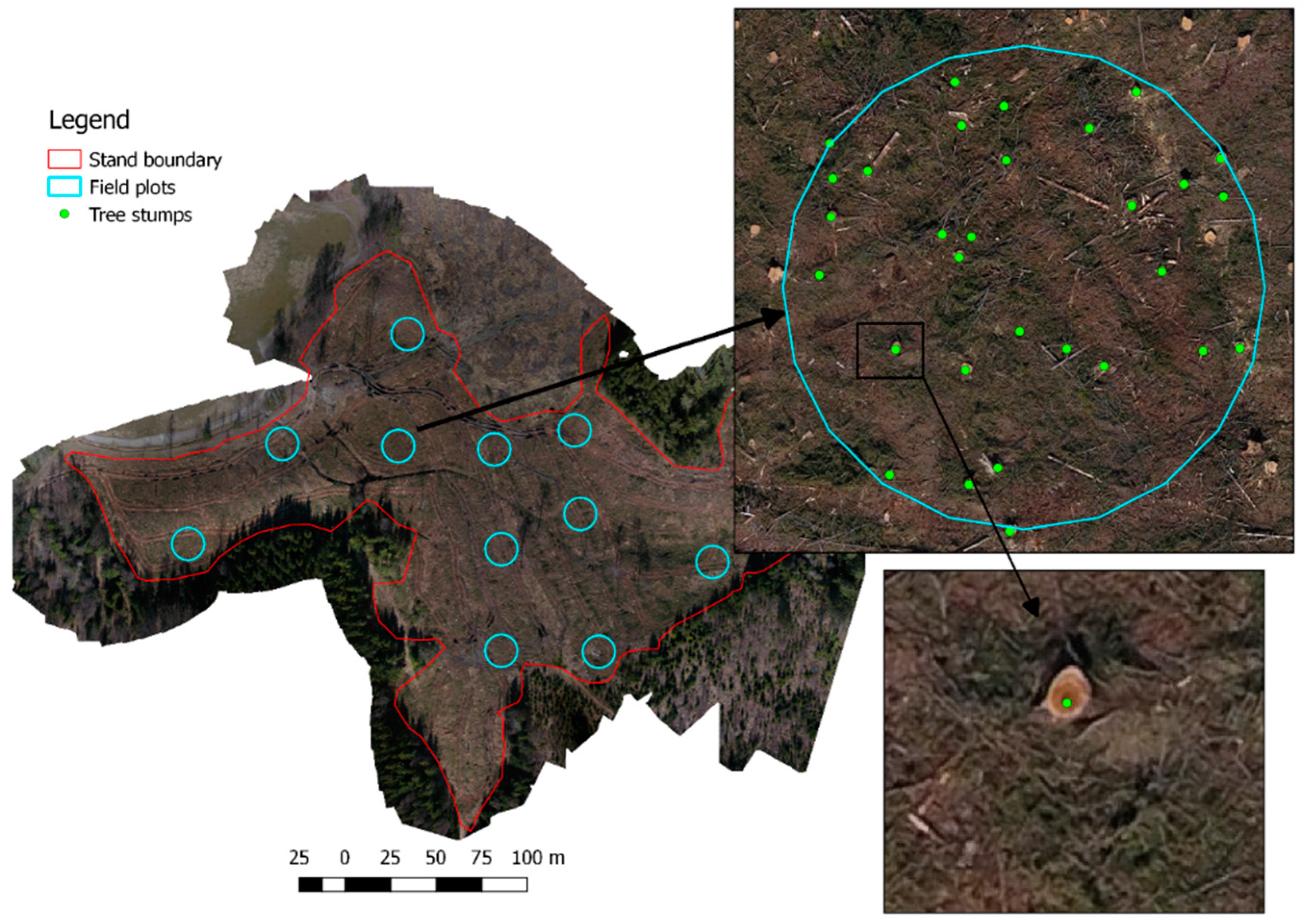
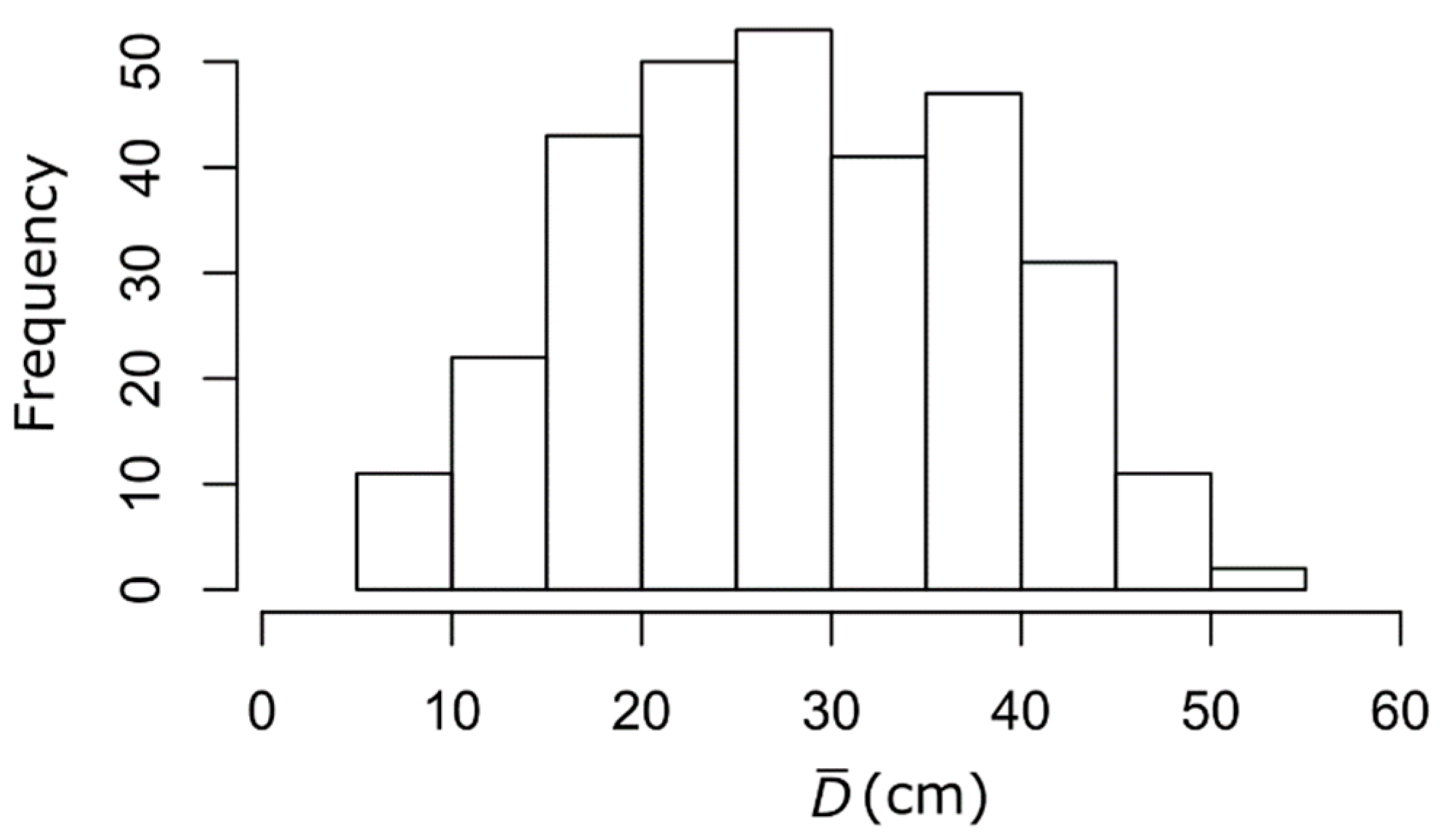
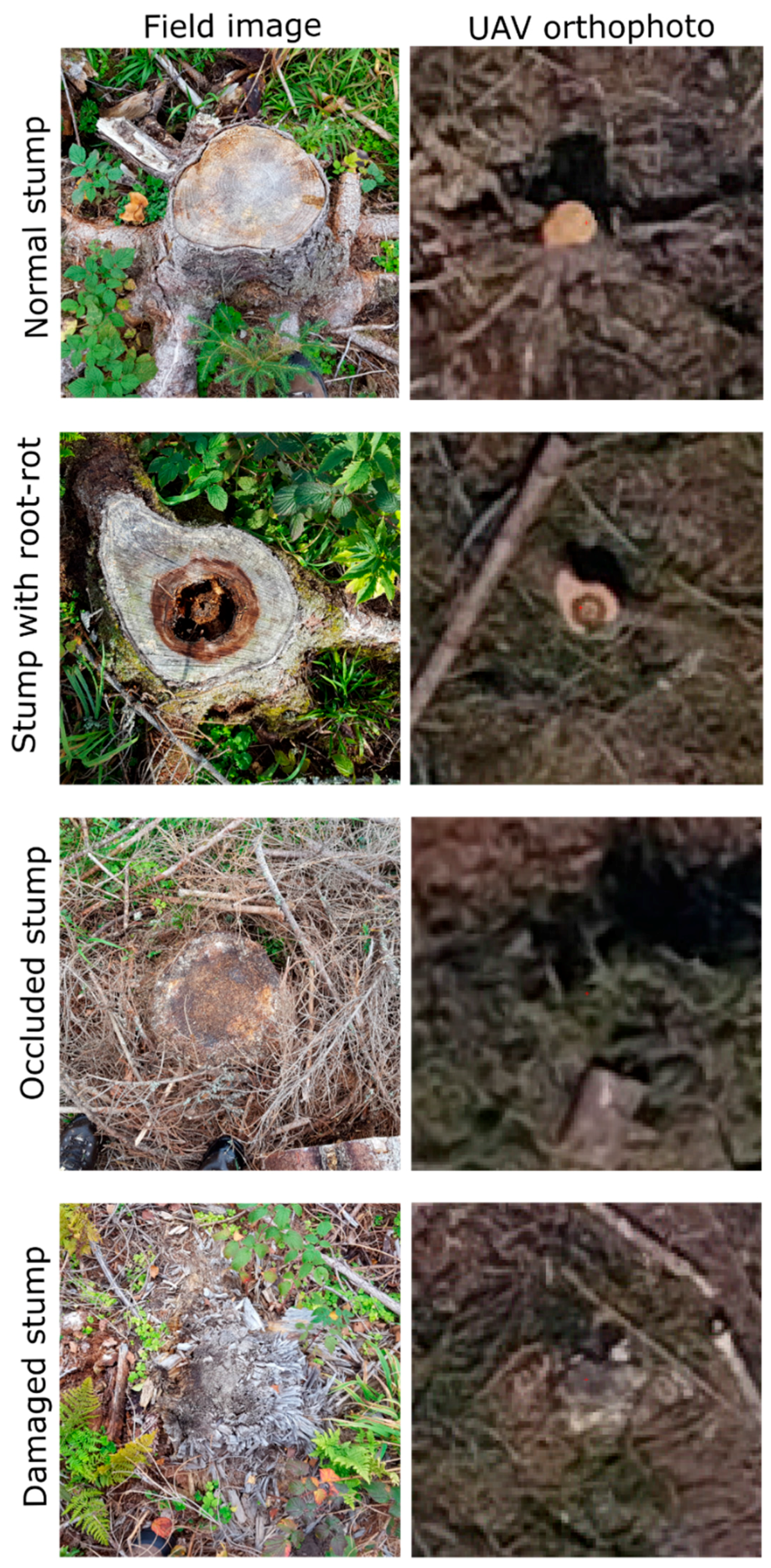
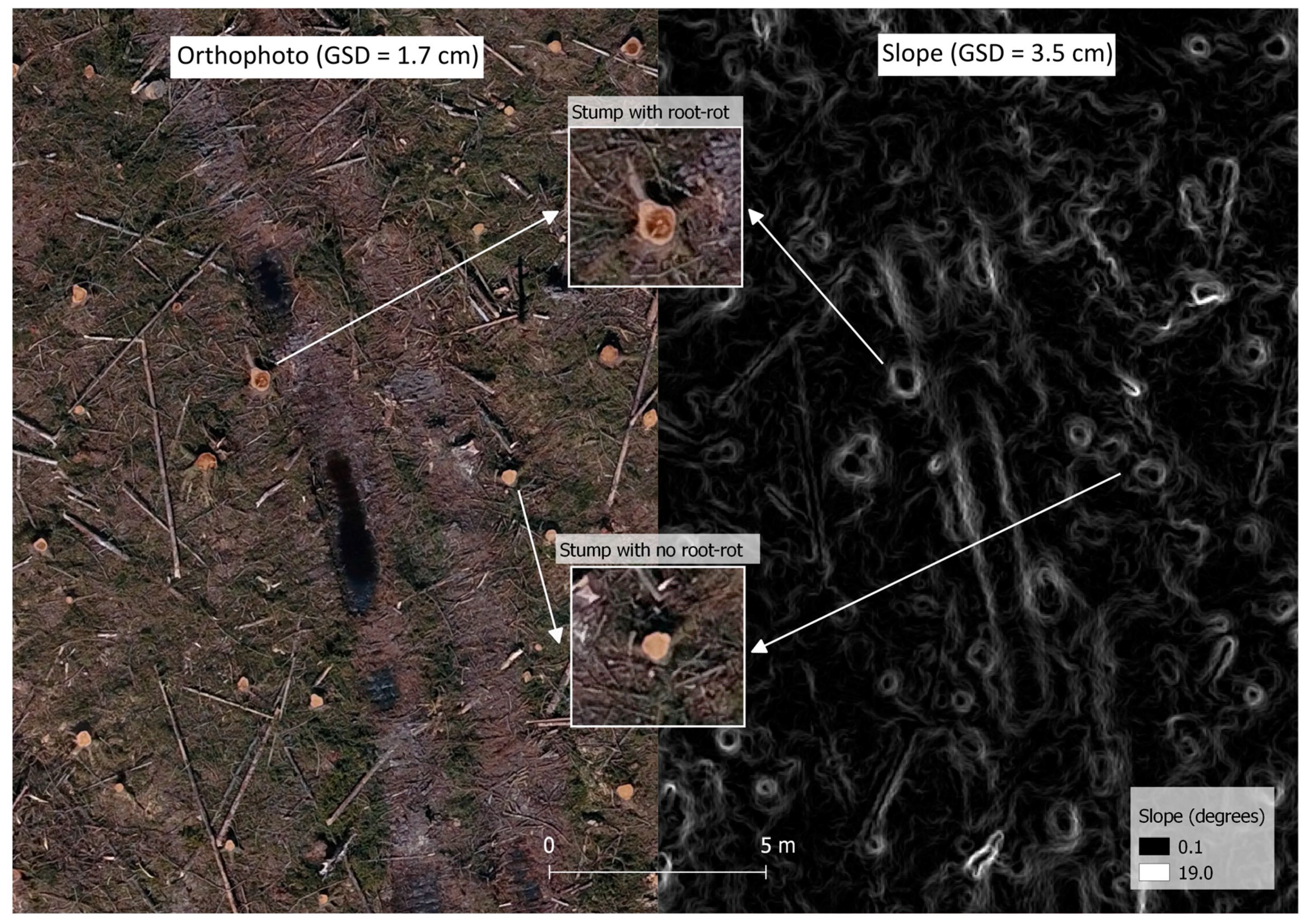
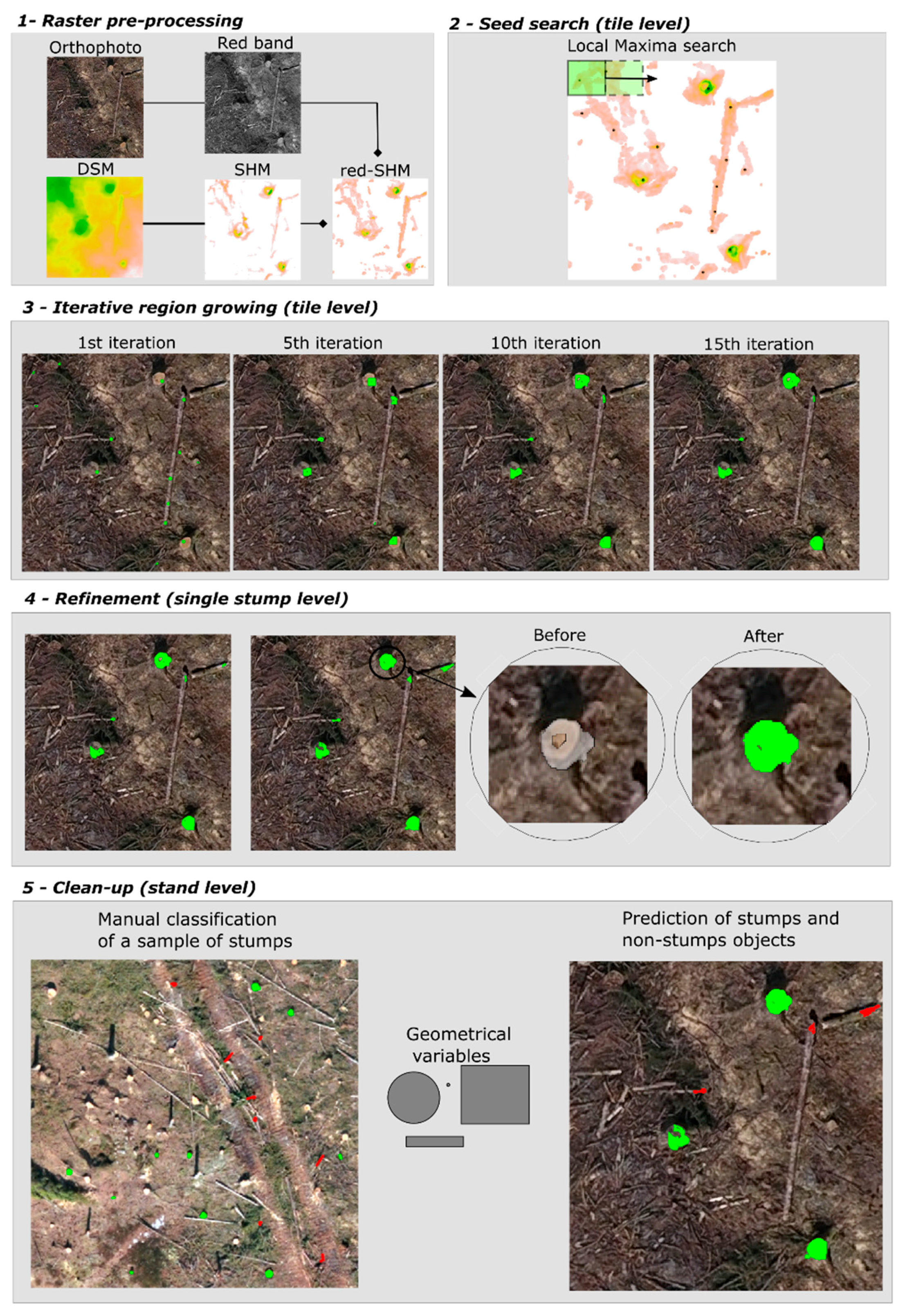
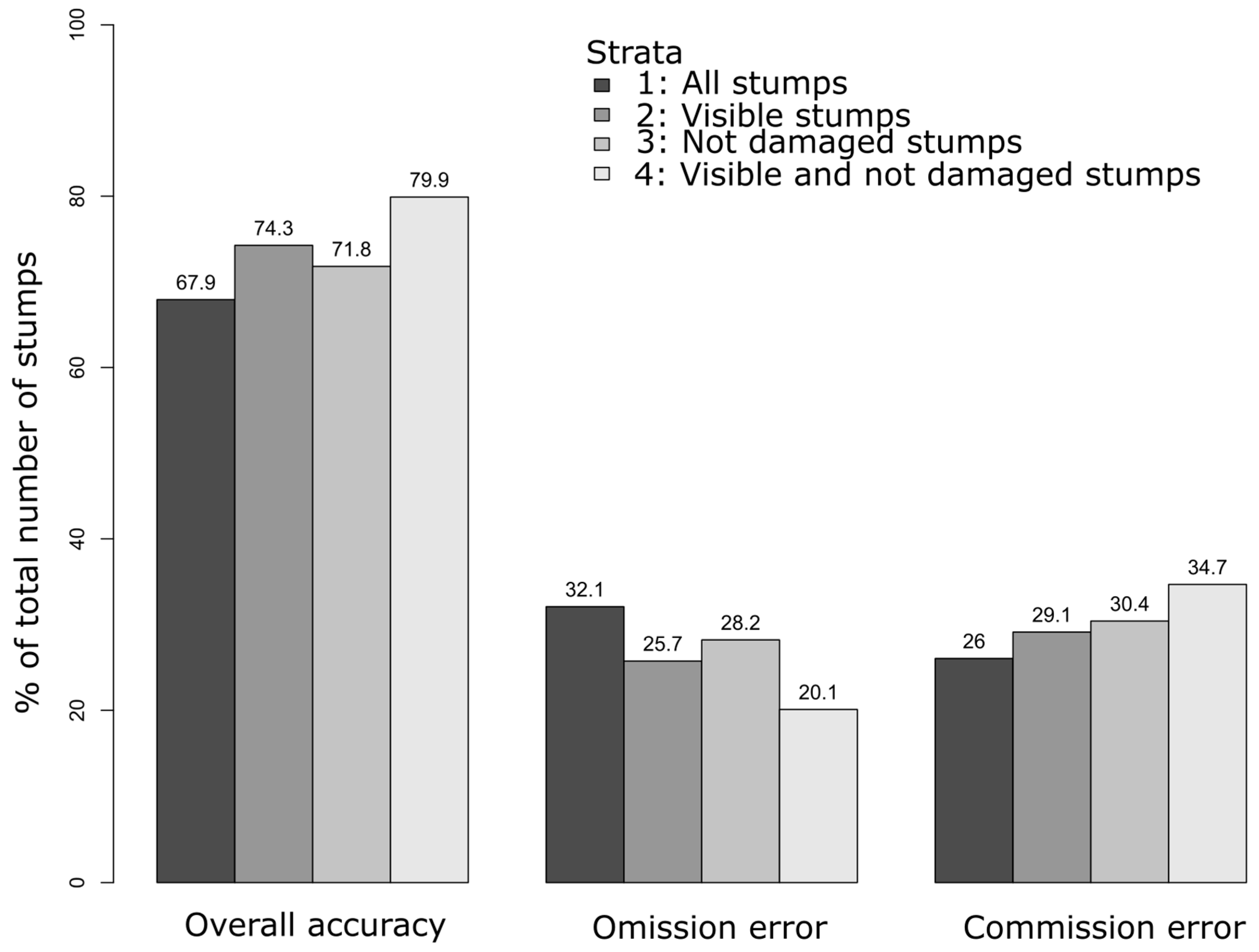
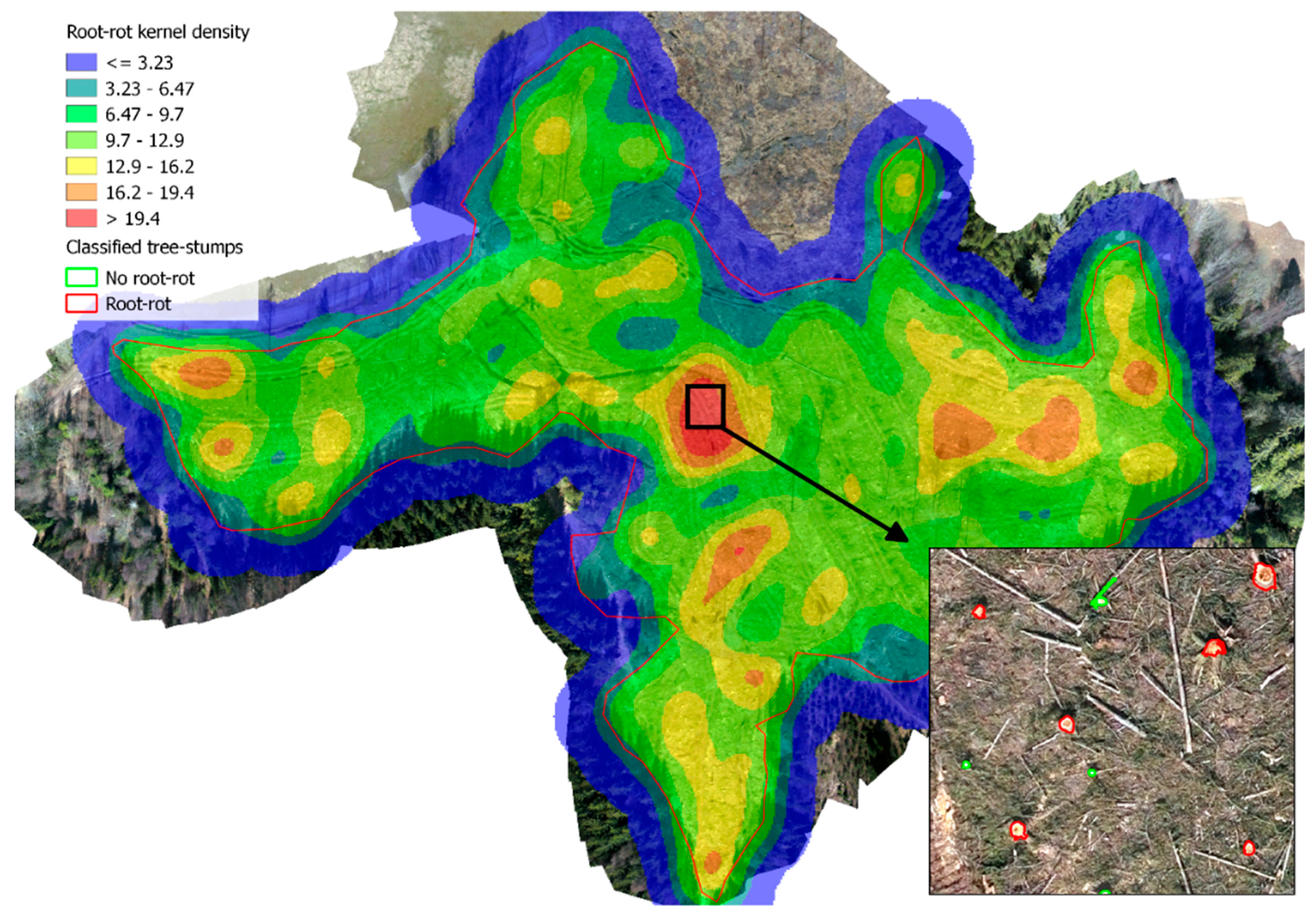

| Variable | Rot Presence | Stump Occlusion | Damage | |||
|---|---|---|---|---|---|---|
| Absent | Present | Not Occluded | Occluded | Intact | Damaged | |
| n | 231 | 34 | 237 | 28 | 227 | 38 |
| % | 87% | 13% | 89% | 11% | 86% | 14% |
| Class. (cm) | Measured (n) | Detected (n) | Omitted (n) | Overall Accuracy (%) | Omission Error (%) |
|---|---|---|---|---|---|
| 0–10 | 7 | 2 | 5 | 28.6 | 71.4 |
| 10–20 | 49 | 25 | 24 | 51.0 | 49.0 |
| 20–30 | 87 | 54 | 33 | 62.1 | 37.9 |
| 30–40 | 79 | 63 | 16 | 79.7 | 20.3 |
| 40–50 | 41 | 34 | 7 | 82.9 | 17.1 |
| 50–60 | 2 | 2 | 0 | 100.0 | 0.0 |
| No. Rot | Root- and Butt-Rot | Classification Accuracy | |
|---|---|---|---|
| No rot | 114 | 39 | 74.5% |
| Root- and butt-rot | 28 | 128 | 82.1% |
| Overall Accuracy | 78.3% |
| Measurement Method | (cm) | (cm) | ||
|---|---|---|---|---|
| Direct measurement | 7.5 | 23.6% | 3.3 | 10.7% |
| Model | 6.4 | 20.2% | −0.004 | −0.013% |
© 2018 by the authors. Licensee MDPI, Basel, Switzerland. This article is an open access article distributed under the terms and conditions of the Creative Commons Attribution (CC BY) license (http://creativecommons.org/licenses/by/4.0/).
Share and Cite
Puliti, S.; Talbot, B.; Astrup, R. Tree-Stump Detection, Segmentation, Classification, and Measurement Using Unmanned Aerial Vehicle (UAV) Imagery. Forests 2018, 9, 102. https://doi.org/10.3390/f9030102
Puliti S, Talbot B, Astrup R. Tree-Stump Detection, Segmentation, Classification, and Measurement Using Unmanned Aerial Vehicle (UAV) Imagery. Forests. 2018; 9(3):102. https://doi.org/10.3390/f9030102
Chicago/Turabian StylePuliti, Stefano, Bruce Talbot, and Rasmus Astrup. 2018. "Tree-Stump Detection, Segmentation, Classification, and Measurement Using Unmanned Aerial Vehicle (UAV) Imagery" Forests 9, no. 3: 102. https://doi.org/10.3390/f9030102




